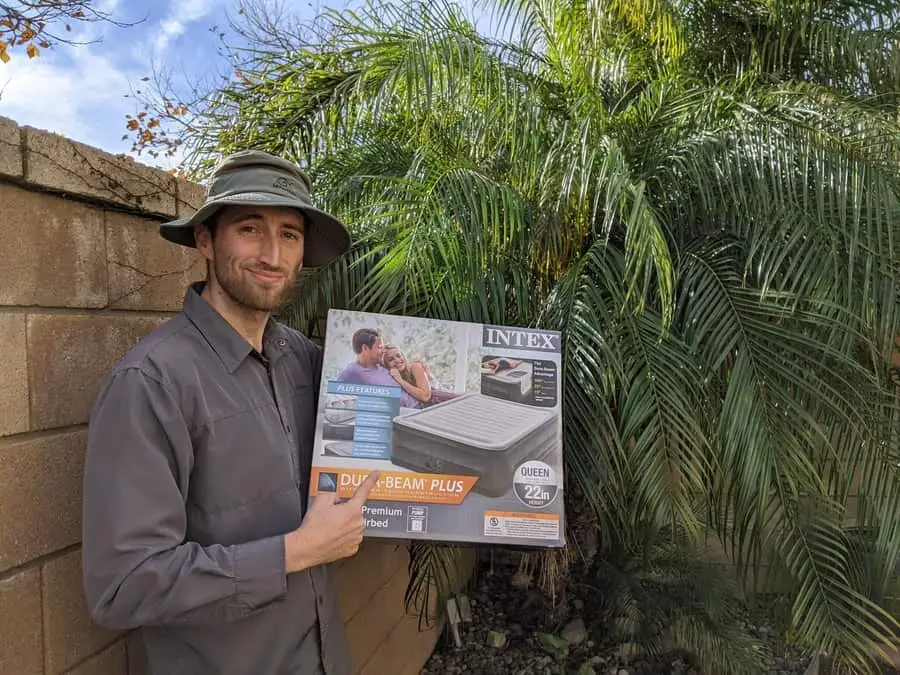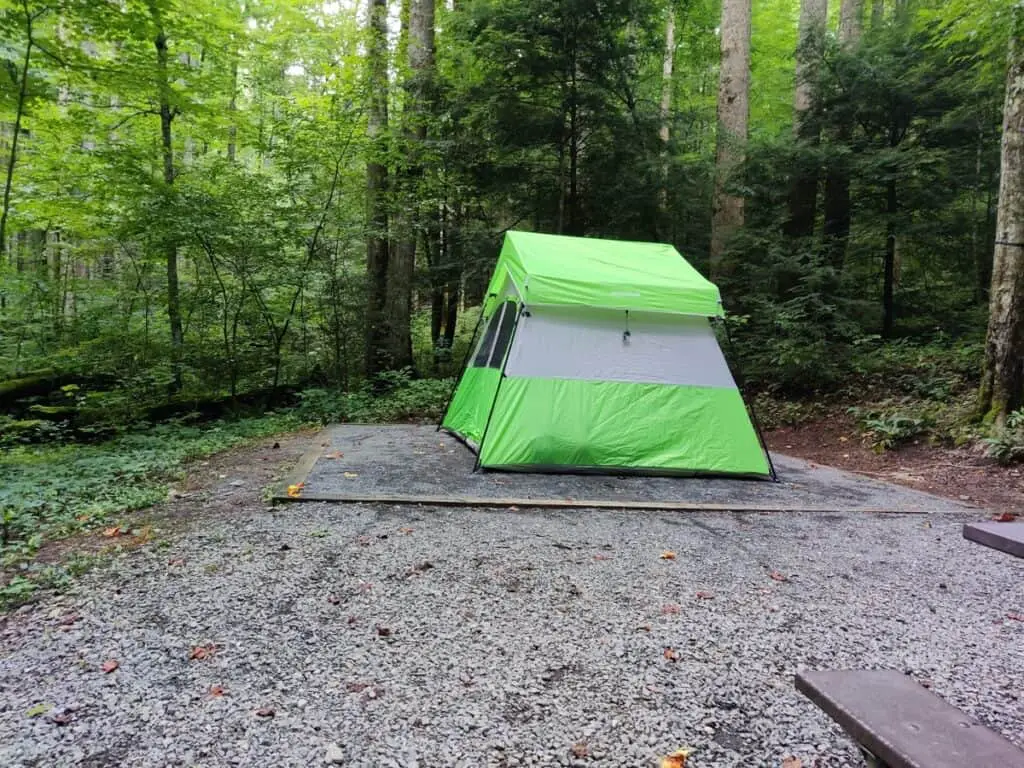
Air mattresses are great for adding some comfort to your camping experience. There is just one small problem; they are not well insulated and can leave you very cold in the middle of the night. Ever since I started camping with air mattresses I often froze in the middle of the night and wondered why that was and if I could prevent it.
I did some research to find out what could be done to stay warm on an air mattress while camping. I want to share what I have learned with you so you too can learn how to insulate an air mattress and have a good night’s sleep while camping.
So, how do you insulate an air mattress? The best way to insulate an air mattress is to get a nice barrier between you and the mattress itself using some kind of insulating material.
It first helps to understand why sleeping on air mattresses can feel so cold and why they are not good insulators. Next, we can gather our solutions to the problem and stay warm while sleeping on a comfy air mattress. It also helps to know what doesn’t work to insulate an air mattress. You can also look for the right air mattress for your camping needs if you are serious about camping, even in a little bit colder weather.
By the way, If you are in the market for a new air mattress, then you should click here to see the one I recommend on Amazon.
Why Do Air Mattresses Feel So Cold?
Just as an important note for air mattresses: I will be referring to the large mattresses that need to be inflated usually by an external pump and they often are similar in size to a normal mattress once inflated. There are sleeping pads that are air-filled too, but they are different than regular air mattresses. Regular air mattresses provide a lot of comfort, but not much insulation from the cold while sleeping pads aren’t as comfortable, but are built to have good insulation.
If you want a full comparison of air mattresses vs sleeping pads then click here to read a full article that I wrote comparing the two.
The ground gets really cold, and anything that separates you from the ground will help alleviate some of that cold temperature from stealing your body’s warmth. That is why you would want to sleep on something off of the ground. Air mattresses bring you off the cold ground and yet they don’t help you get very much warmer. The primary reason for this is that the air inside of the air mattress eventually resembles the same temperature as the ambient temperature surrounding it.
Air mattresses aren’t all that thick either and the cheaper ones are made from thin polyvinyl chloride (PVC). Basically, there is not much room between you and the cold air inside the air mattresses besides a thin sheet of plastic. The result is a loss of body heat from being in contact with the cold air. Herein lies our solution to insulate our air mattress and keep ourselves warmer.
How To Insulate An Air Mattress
| Ideas To Insulate An Air Mattress | Effectivenesss |
| Place a sleeping pad on top of the air mattress | High |
| Use blankets between you and the air mattress | Medium |
| utilize a foam mattress topper | High |
| wear more clothing layers | Medium |
| get a camping-specific air mattress | Low-Medium |
The main idea on how to insulate any air mattress is to separate your body from being in contact with the cold air mattress itself. Do this by adding layers of insulating material between yourself and the air mattress. Of course, you could always get a good air mattress that already has some insulation built-in, but If you want to try out using your old cheap one, it is going to take some serious layering in most cases.
The best solution, in my opinion, is to get a well-insulated sleeping pad to place on top of the air mattress. That way you will be getting the best of both worlds with the comfort of a regular air mattress and the insulation of the sleeping pad. I talk about the comparison of sleeping pads and air mattresses in-depth in this article I wrote. You have many options to choose from with sleeping pads, but your main concern here is good insulation since you already have a regular air mattress beneath it. A nice closed-cell foam sleeping pad might be best since it provides the best insulation for your body.
Another solution that could help with insulating the air mattress is to layer a bunch of blankets between you and the mattress. The thicker the blankets, the better for insulating. Wool blankets are probably the best for really cold weather since they are one of the “warmest” fabrics. Any blankets will do though, although it’s not exactly convenient carrying a bunch of blankets, they can do a good job of keeping the cold air in the mattress from stealing your body heat. Choose warmer fabrics and you won’t need to bring as many blankets.
In addition, a regular foam mattress topper can provide some insulation. It won’t be as good as a camping-specific foam sleeping pad, but the foam topper is a very good insulator. Again, it might not be convenient to carry around a foam mattress topper with you camping, but if you already have one at home and don’t mind getting it dirty then have at it. You can now get the foam mattress toppers with washable covers so it becomes easier to take them camping and clean them afterward.
An often forgotten way of keeping warmer is to wear more layers or clothing better equipped for cold weather. You would be surprised what a simple hat and a good pair of socks could do to keep you warm on a cold night. Additionally, long underwear and long undershirts can do very well at trapping heat against your body. Don’t forget to bring the proper warming layers with you and you might not need as much insulation on the air mattress itself.
The basic premise is to put a layer between you and the air mattress using a good insulator. You do not want your body in close contact with the cold air inside the air mattress if you are trying to stay warm. Another viable option is to get a better air mattress for camping if you are ready for the next level. In any case, don’t forget to bring something to inflate your air mattress! Did you know that there are several ways to inflate an air mattress? Click here to read another article that I wrote with several ideas on how to inflate your air mattress while camping.
How NOT To Insulate An Air Mattress
Don’t waste your time and effort putting something between the floor and your air mattress for insulation. If you want to do it in order to protect your air mattress then that’s a valid reason, but it won’t help insulate your air mattress. The air mattress’s internal temperature will still reach a temperature that closely resembles the ambient temperature and you will be no better off.
Staying warm while camping is all about generating and maintaining your body heat. Keeping your body away from being in contact with cold surfaces will help you not lose most of your body heat. The basic idea of keeping warm with an air mattress is similar to keeping warm with a sleeping pad. That’s why with sleeping pads you generally keep them underneath and separate from your sleeping bag. Click here to read an article that I wrote and learn more about how to properly use a sleeping pad for camping.
What To Look For In An Air Mattress

Although you could use any air mattress for camping, the cheaper ones are only really good for perfect weather. If you want one that can stand up to more variable conditions then getting an air mattress designed from camping is going to be your best bet.
Look for one with a good “R-Value” this value is a measure of thermal resistance. Hence the “resistance-value”. The higher the R-value of the air mattress, the more thermally resistant the air mattress is. In plain English this means that a high R-value is better suited for colder temperatures and a lower R-value is not well suited for cold temperatures. If you have a cheap air mattress then assume it has a very low R-value or a practically non-existent one.
You can get air mattresses with self-insulation built with internal synthetic material. Usually, this insulation won’t be as good as sleeping pads, which is why I recommend combining both of them to get the best features that they each have to offer. At the end of the day, if your air mattress just isn’t working out for you, you could always get a camping cot. They lift you off the ground and are much warmer than ordinary air mattresses. You should be just fine in most circumstances if you follow the tips I have outlined.
Conclusion
If you want to insulate your air mattress you are going to need to put a layer of insulating material between you and the air mattress itself. Some of the best options for doing so are using a sleeping pad, blankets, and a mattress topper. You can use pretty much any material that is a good insulator. Don’t forget one important way of staying warm; proper warming layers and clothing. If you are able to get a better air mattress designed for camping and dress smartly for the weather then you can be prepared for just about anything.
Related Questions
What Is The Best Thing To Put Under An Air Mattress While Camping?
The best thing to put under an air mattress while camping is your tent on a flat surface free from sharp objects. An additional tarp underneath your tent can help cushion your air mattress and keep it safe from sharp objects like rocks and sticks.
How Do You Protect An Air Mattress While Camping?
In order to protect your air mattress while camping, Keep your air mattress inside your tent and away from sharp objects. Do not overinflate or under-inflate your air mattress and never stand on top of your air mattress while camping.
My Favorite Camping Gear
- Air Mattress: click here
 to check out my favorite on Amazon.
to check out my favorite on Amazon. - Tent: click here
 to see my favorite tent available on Amazon.
to see my favorite tent available on Amazon. - Sleeping Pad: click here
 to check out the one I love on Amazon.
to check out the one I love on Amazon. - Sleeping Bag: click here
 to see the one I recommend on Amazon.
to see the one I recommend on Amazon. - Camping Stove: click here
 to see the best camping stove on Amazon.
to see the best camping stove on Amazon.

